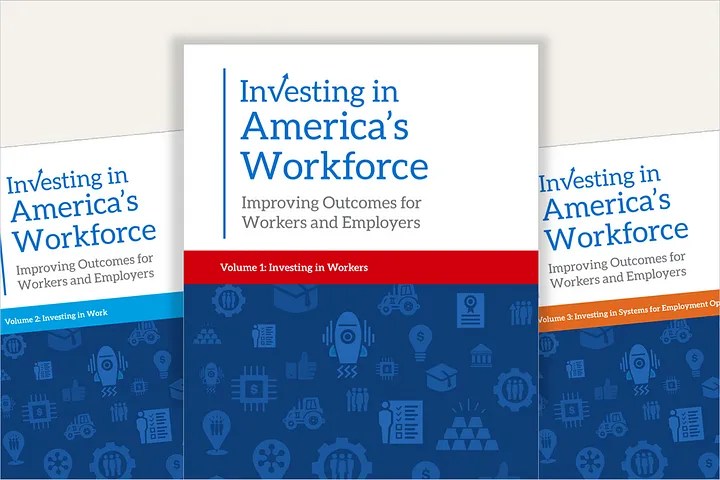
Continuing from a post earlier this year about the Federal Reserve System-led IAW initiative, I am pleased to announce the release of Investing in America’s Workforce: Improving Outcomes for Workers and Employers. As co-editor of the publication, I am excited about the release of this three-volume collection that features the knowledge and experience of workforce and community practitioners, and scholars from around the nation. On Friday, November 9, 2018, the New York Federal Reserve Bank will host and co-sponsor the Investing in America’s Workforce Book Launch Event. Over 100 participants will join me to hear 20 national leaders discuss systemic barriers to employment and the strategies and investments that are helping to overcome those barriers.
Transforming U.S. Workforce Policies for the 21st Century, 2015
In 2015, in collaboration with the Federal Reserve Banks of Atlanta and Kansas City and the John J. Heldrich Center for Workforce Development at Rutgers University, we released Transforming U.S. Workforce Development Policies for the 21st Century, which included over 30 chapters by many of the nation’s foremost experts. It examined the state of the labor market and potentially transformative, evidenced-based workforce development and education strategies designed to improve opportunities for job seekers, students, and workers while also addressing the need of employers for highly trained productive employees.
Investing in America’s Workforce: Improving Outcomes for Workers and Employers
Investing in America’s Workforce continues this collaboration with additional partners, including the Ray Marshall Center for Human Resources at the University of Texas-Austin and all of the regional banks of the Federal Reserve System. The three volumes include nearly 70 chapters prepared by leading analysts, advocates, and policy makers. These essays examine promising and proven strategies to assist students, workers, employers, and workforce development systems.
Investing in America’s Workforce highlights programs and policies that are improving outcomes for workers, employers, and communities across the country. The three volumes examine Investing in Workers, Investing in Work, and Investing in Systems for Employment Opportunity. Each volume includes chapters that identify specific workforce development programs and policies that provide positive returns to jobseekers, employers, and society.
· Volume 1, Investing in Workers, discusses all job seekers — and especially disadvantaged workers — as opportunities and assets rather than deficits. Workers left out of the recovery, such as long-term unemployed and chronically unemployed youth, are important sources of untapped talent in a tight labor market and bring new and different perspectives and skills to businesses.
· Volume 2, Investing in Work, examines the value that firms derive by addressing their employees’ human resource challenges. Programs that support in-service training, enhanced quality of work and fringe benefits. Many firms have found that these strategies boost productivity and reduce turnover.
· Volume 3, Investing in Systems for Employment Opportunity, explores the different ways organizations and policymakers deliver training and support worker and business productivity.
Essays examining innovations in technologies service delivery and as innovative finance models, are included.
At the Book Launch Event, I will be moderating a panel on Investing in Workers with Maurice Jones from LISC, Todd Greene from the Atlanta University Center Consortium, and Marc Morial of the National Urban League. I look forward to seeing you there.
Accessing the Publication
If you are not attending the book launch on November 9, you can obtain, without charge, all three volumes or individual chapters of Investing in America’s Workforce: Improving Outcomes for Workers and Employers at www.investinwork.org.
This article was originally published by the New York Fed on Medium.
The views expressed in this article are those of the contributing authors and do not necessarily reflect the position of the New York Fed or the Federal Reserve System.










